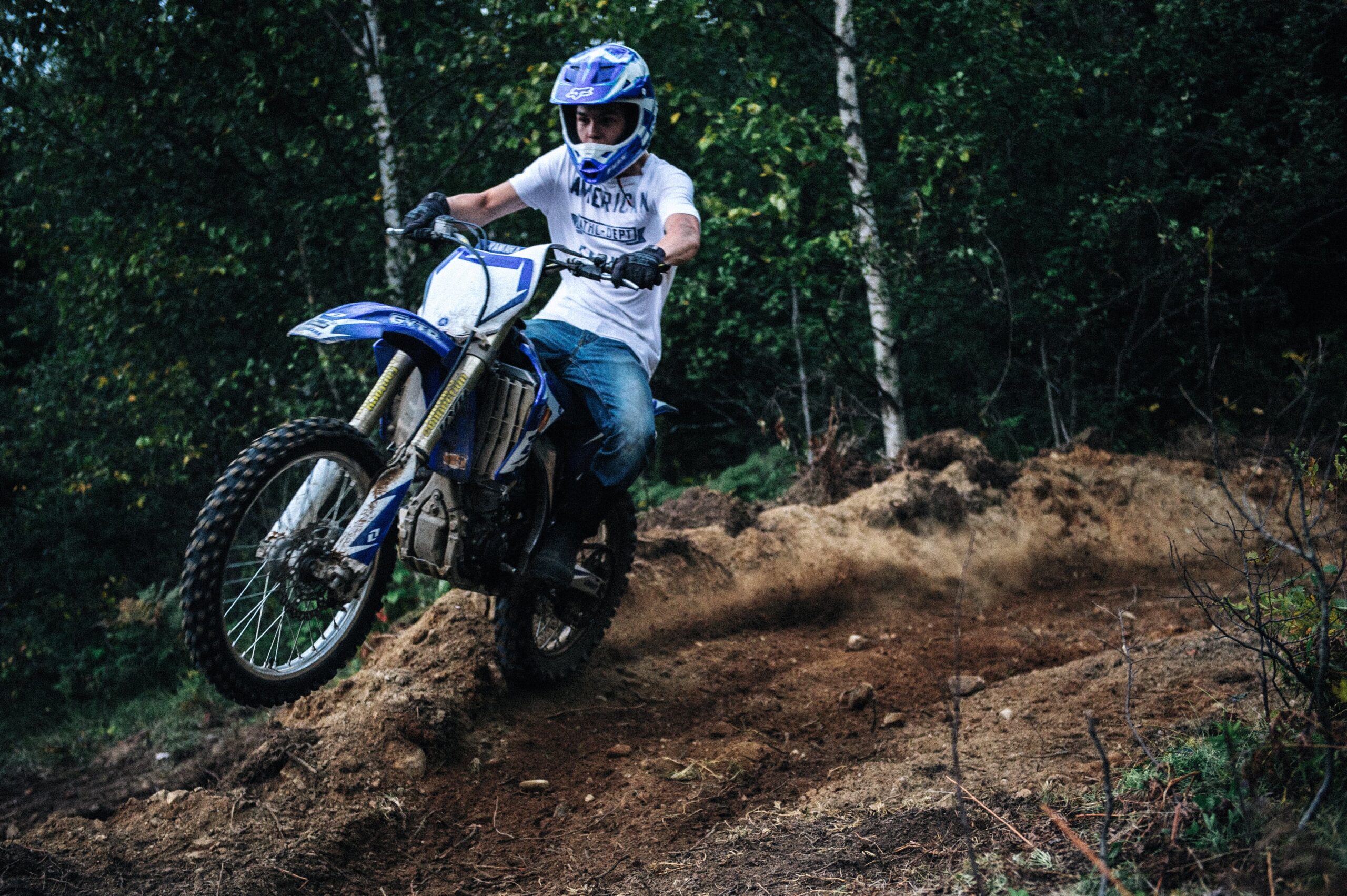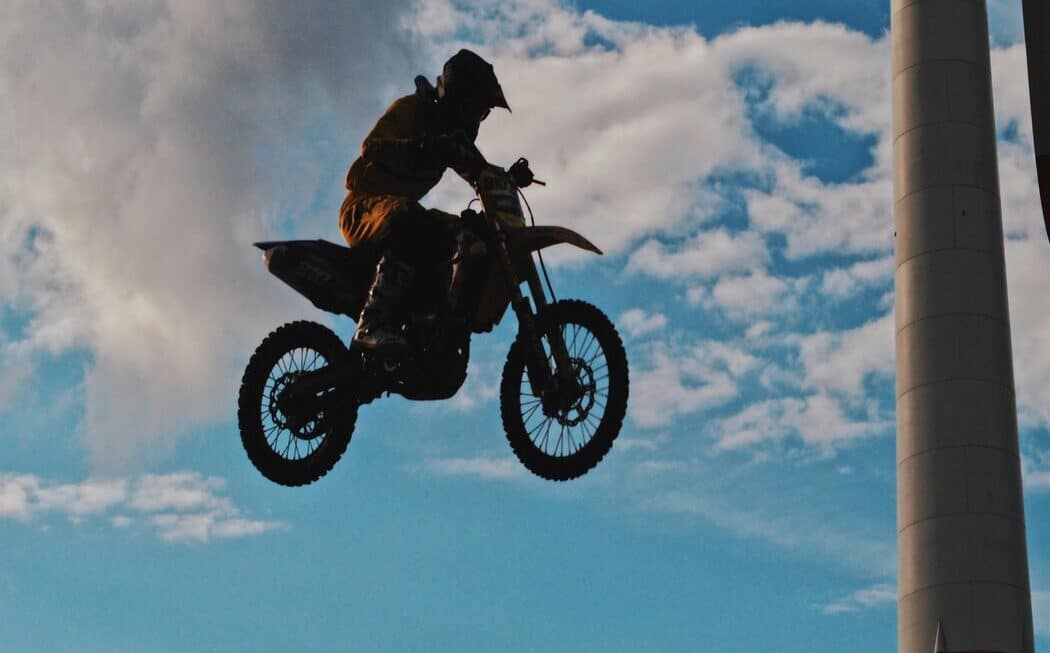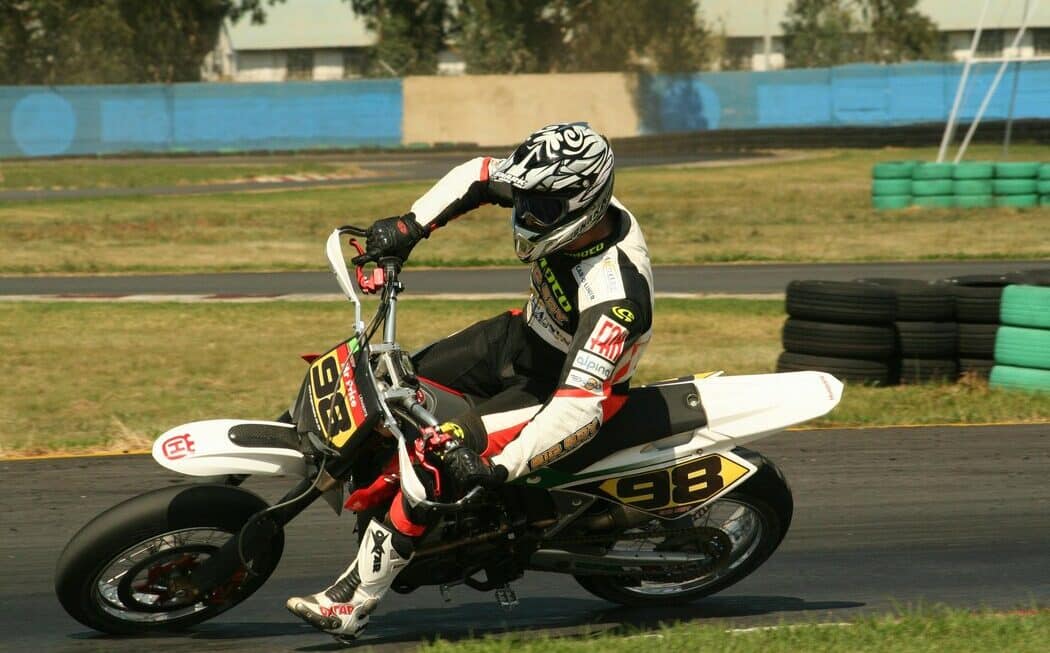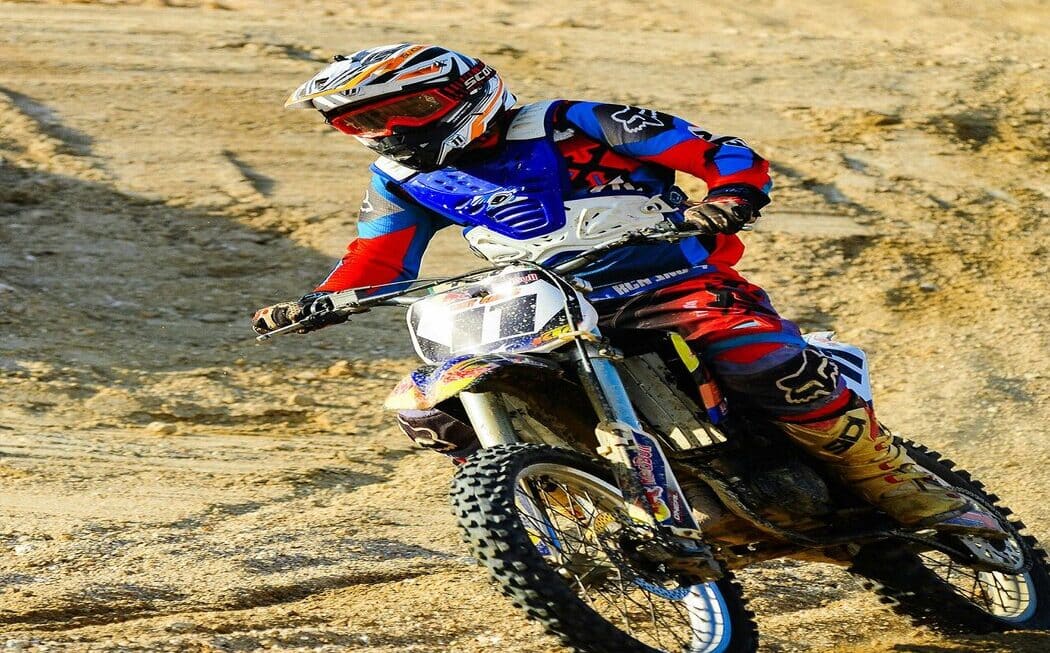The question of how far a dirt bike can go on a tank of gas is not an easy one to answer because there are so many factors at play. On average, riders can expect to get between 50 and 100 miles (80 to 160 kilometers) out of a full tank of gas. However, the exact distance depends upon the type of engine in the bike, the terrain, and the riding style. For instance, four-stroke engines are more fuel efficient than two-strokes, and riding on flat terrain will consume less fuel than climbing steep hills or dunes.
Along with considering these variables, it helps to understand the capacity of each bike’s gas tank and calculate the maximum travel distance from that figure. Additionally, there are tips riders can use to increase their overall fuel efficiency while out on the trails or tracks. These include adapting riding styles for optimum economy such as maintaining an average speed instead of accelerating excessively; wiping air filters clean; checking tire pressure; and ensuring spark plugs are tuned correctly. With this knowledge in hand, any dirt biker can take steps toward getting more out of each tankful and making sure they don’t run out of fuel mid-ride.
Factors Affecting Gas Tank Efficiency of Dirt Bike
The gas tank efficiency of dirt bikes is affected by several factors.
Riding Style
Riding style is an important factor to consider when trying to conserve fuel on a dirt bike. Aggressive riding with frequent acceleration and high-speed bursts will cause more fuel to be consumed than a more conservative riding style. These aggressive maneuvers not only require the engine to work harder but will also force you to constantly make adjustments for shifts in terrain, like jumps or bumps in the road. Ultimately, this will result in your needing more fuel for your ride.
Alternatively, if you maintain a steady pace while riding and take advantage of smoother terrain, such as trails or flat paths rather than hillsides or inclines, you can conserve more gas over time. This sort of riding utilizes a low gear setting so that your speed remains moderate and requires less machine power from the engine. Additionally, progressing through each area of terrain at a consistent speed means fewer readjustments need to be made throughout the trip; ultimately leading to less wasted resources as the effect those constant readjustments have on overall fuel consumption is immense.
Maintenance
Maintenance is an important part of keeping any machine or appliance running at peak efficiency. This holds for cars, bikes, and other motorized vehicles as well. A well-maintained engine can improve efficiency by using less fuel, resulting in fewer emissions into the atmosphere. In addition, a regularly serviced and tuned engine can help to maintain the engine over time and may even prevent major repairs down the line.
Annual services are a great way to ensure that your vehicle is running as efficiently as possible. During these services, mechanics can check for any worn parts or wear on key components such as seals or gaskets that could lead to leaks or unnecessary wear on other parts. Furthermore, they are more likely to be able to spot minor issues before they become bigger problems requiring more expensive repairs. Taking the time to routinely service your vehicle will give it the best chance of achieving optimal performance while reducing potential repair costs in the future.
Engine Type
2-stroke and 4-stroke engines are two of the most common types used in engines for vehicles. They are both designed with the same purpose in mind – to convert combustible fuel into a useful form of energy – but they each do it in different ways. 2-stroke engines, which are usually found in smaller, low-output motors, utilize a rapid combustion cycle to quickly propel a piston up and down. This process results in high power production at the cost of fuel efficiency.
4-stroke engines, on the other hand, use four distinct strokes of a piston within an enclosed cylinder to produce energy from combustible fuel. This extended and more efficient process yields higher levels of fuel economy compared to its 2-stroke counterpart. The power output may not be as high as that of a 2-stroke engine, but the overall efficiency provided by modern 4-stroke combustion engines makes them well-suited for today’s automotive applications. Additionally, advancements in engine technology have made 4-strokes increasingly economical, while also reducing emissions for cleaner operation on the road.
Engine Size
Engine size is an important factor when considering a dirt bike purchase, as it affects a range of areas from fuel efficiency to power and top speed. Smaller engine sizes tend to be more fuel efficient as they require less fuel to drive the same distance or accelerate at the same rate compared to larger engine sizes. This can lead to a more affordable everyday driving experience, while also keeping emissions low. Although smaller engines can be great for saving money in the long run, they sometimes come with limitations in terms of power and top speed. For those looking for vehicles with higher performance or that can reach faster speeds, larger engine sizes might be a better choice despite their lesser means of efficiency.
For instance, a car equipped with a 1-liter engine might perform better than its 1.6-liter counterpart in economy driving situations. However, this 1-liter model may not have as much power or reach the same top speeds as the larger engine that has more cylinders and displacement capable of faster accelerations. Findings from automotive reviews and research studies often display this tradeoff between efficiency and performance where small engines tend to perform best in city driving applications while large engines are typically better for highway performance or specialized conditions such as off-roading or race tracks.
Terrain
Riding on challenging terrain with its various obstacles requires significantly more power and fuel from a dirt bike than one would typically need on a smoother track. This can eat away at an electric dirt bike’s battery life, making it difficult to cover longer distances. As such, the range of an electric dirt bike is greatly affected by the ruggedness of the terrain and the number of obstacles present.
To counteract this issue, manufacturers are introducing new extreme off-road options for electric vehicles, including powerful motors and larger batteries that help increase the distance they can travel on one charge. Many of these innovative designs also come with unique features that can tackle technical trails more effectively, such as improved grip thanks to deep tread tires and advanced suspension systems that absorb shock when faced with large bumps and jumps. With these upgrades in place, electric dirt bikes can travel further despite their heavier weight and drawn-out charging times compared to petrol models.
Approximate Fuel Tank Capacity for Dirt Bikes
Fuel is an essential part of dirt biking and your bike’s tank capacity can make or break a fun day out on the trails. Even the most experienced riders need to know approximately how much fuel their bike can hold and how long it will last before they need to refuel. Electric dirt bikes tend to have more consistent fuel tank capacities than other types of dirt bikes as they are powered by an onboard motor and battery.
Approximate fuel tank capacities for electric dirt bikes range from 2 liters or 1 gallon to 10 liters, depending on the specific model. This range means that depending on the type of terrain you expect to be riding on, you may want a larger capacity tank if you plan on traveling longer distances. Inline two-stroke engines require slightly more frequent refueling due to their high power output which leads to more frequent stops for refueling. On the other hand, four-stroke engines provide superior efficiency in comparison, meaning that you should be able to cover a longer distance without having to stop as often for refueling stops.
Tips to Increase Dirt Bike Gas Efficiency
If you want to get the most out of your dirt bike’s performance and fuel efficiency, there are some tips you can take to increase its range and cut down on fuel costs.
Smooth Dirt Bike Acceleration and Braking
Smooth dirt bike acceleration and braking are essential components of best-practice maintenance when driving. Adopting a gradual and measured approach to driving offers numerous advantages for your fuel economy, safety, and personal comfort. When you accelerate gently, you reduce the strain on your engine’s components and improve fuel efficiency. Also, by anticipating stops further in advance of intersections or turns, you can allow yourself ample time to slow down gradually instead of slamming on the brakes at the last minute. Such behavior not only minimizes wear-and-tear on your brakes but also prevents aggressive accelerations that result in wasting more fuel.
Although it may seem like second nature to simply hit the gas pedal hard upon entering an intersection or overtaking a car in front of you, this habit can be much less efficient for your dirt bike than a softer touch. Resist the urgent urge to floor it at all times; taking it slow and steady will contribute both to improved fuel consumption as well as road safety overall. Remember – a light touch on both the accelerator and brake pedals can go a long way in conserving natural resources while providing a smoother ride during your daily commute.
Dirt Bike Proper Vehicle Maintenance For Maximum Gas Average
Keeping your dirt bike properly maintained is essential in increasing its gas mileage. Regularly changing the air filter and spark plugs at recommended intervals can improve airflow to the engine, which reduces workload and conserves fuel. A clogged air filter impairs the engine’s ability to take in air from outside, forcing it to work harder than necessary which then decreases efficiency. Similarly, worn-out spark plugs lead to incomplete combustion resulting in fewer miles per gallon of gasoline consumed.
To save money on fuel and improve overall performance, sticking to a motorcycle maintenance schedule is a must. If any issues are spotted on your vehicle such as dirty filters or frayed wires then they should be addressed immediately rather than waiting until the next service appointment. By maintaining your dirt bike properly you’ll not only keep it running better for longer but also increase gas mileage however small these gains may be. Fuel prices can skyrocket so even a few extra miles per gallon of gasoline can benefit your finances by providing more bang for your buck at the pump!
Do Not Stay Idle on a Dirt Bike
Riding a dirt bike requires careful consideration of the environment and your engine’s best performance. To optimize both, it is important for riders to not stay idle with their engine running for extended periods. Every moment that the engine idles, fuel is being consumed unnecessarily. This applies whether you’re waiting or parked – if you anticipate being stationary for more than a minute or two, shutting off your engine is an easy way to conserve fuel and reduce emissions.
Modern vehicles are designed to handle frequent starts without damage or strain on the engine, so there’s no need to keep it running when you can avoid it. By avoiding idling on your dirt bike, not only will you save fuel and reduce pollution; but also contribute to quieter and cleaner surroundings around you and within your community! So next time you’re riding on your dirt bike, remember: don’t stay idle!
Plan Efficient Routes For Good Fuel Average of Dirt Bike
When planning a route for a dirt bike, efficiency is key. By strategically selecting routes with minimal traffic congestion and frequent stops, your dirt bike will be able to conserve more fuel and get you where you need to go more cost-effectively. One great tool to help with route planning is a navigation app or GPS device. This type of real-time traffic information will allow you to easily find out about road closures or heavy traffic areas, and provide possible alternative routes that may avoid these issues.
In addition to using navigation apps, it’s also beneficial to plan out your trips ahead of time and consider the timing of when you are driving, such as avoiding rush hour times during the day or night. Planning can be extremely helpful in reducing idling time in jams, finding efficient roads with minimal stops along the way, and ultimately leading to better fuel economy for your dirt bike and improved stress levels and satisfaction from your journey.
Maintain Proper Tire Pressure Of Dirt Bike
Maintaining proper tire pressure is essential for optimal performance and safe operation of your dirt bike. Most motorcycle manufacturers recommend that the tires be inflated to a specific pressure, which can often be found in the owner’s manual or on the driver’s side door jamb. Underinflated tires create higher rolling resistance, which makes the engine work harder and consume more fuel.
Checking your tire pressure regularly, ideally once a month, is an important part of routine maintenance. It will help ensure that you maximize fuel efficiency and improve on-road handling. Properly inflated tires also last longer than those with low tire pressures and prevent potential blowouts that can occur if they are severely underinflated. Tire wear will increase considerably with improper inflation and could put you at risk for flat spots or worse, tire failure while riding at high speeds. So make sure to always maintain proper dirt bike tire pressure for both maximum enjoyment and safety from any road hazards ahead!
Aerodynamics Of Dirt Bike and Gas Average
One of the key factors in improving a vehicle’s fuel economy is aerodynamics. An aerodynamic vehicle moves more easily through the air and therefore uses less energy to push it forward. A dirt bike is especially sensitive to aerodynamic drag, due to its relatively slow speeds and small size. Fortunately, there are some simple steps you can take to increase your bike’s fuel efficiency by improving its aerodynamics.
Closing the windows on the dirt bike while in transit provides a great improvement for several reasons; firstly, it prevents open air from entering the cabin which creates drag that may cause fuel consumption to skyrocket when traveling at high speeds. Secondly, removing any roof racks or accessories while not in use can also help reduce drag as they disrupt airflow over the body of the vehicle and act as an obstacle for air passing past. These two measures will reduce overall air resistance faced by your dirt bike, thus increasing gas mileage while bringing down your carbon footprint – two benefits that every conscientious biker should appreciate!
Use the Right Gas In Your Dirt Bike
Using the right gas in your dirt bike is an important factor when it comes to ensuring its optimal performance. Most dirt bike manufacturers list a specific fuel grade that should be used in their respective models. This specification isn’t simply a suggestion, it is based on extensive testing and engineering with your particular bike in mind. Ignoring this recommendation can lead to issues such as knocking, reduced power, and decreased fuel efficiency – not to mention unnecessary costs.
Using higher-grade fuel than necessary won’t offer any additional benefits but it will increase your expenses significantly. Investing in the recommended grade of gasoline for your dirt bike helps make sure that you know exactly what type of fuel your engine needs. Not only will you save money, but you’ll also ensure that your engine runs more efficiently and with maximum power. By adhering to your vehicle’s fuel requirements, you’re taking care of both the present and future performance of the machine while reaping great rewards such as improved fuel economy and overall performance from time to time.
Conclusion
In conclusion, the distance a dirt bike can travel on a full tank of gas depends on various factors that require careful consideration. Electric dirt bikes can typically cover between 50 to 100 miles while gasoline-powered engines usually achieve around 200 miles. It’s important to note that fuel efficiency can be improved with proper maintenance and by applying tips such as avoiding wide-open throttle for extended periods, reducing speed, and riding in higher gear. Knowing your bike’s range is essential for planning rides and achieving optimal fuel economy throughout the journey. Whether you’re looking for an adrenaline rush or simply want to enjoy some scenic vistas, understanding your motorbike’s fuel usage will make any off-road adventure much more enjoyable.



